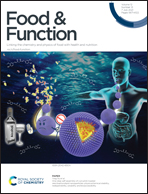Lactobacillus fermentum CQPC08 protects rats from lead-induced oxidative damage by regulating the Keap1/Nrf2/ARE pathway
Abstract
In this experiment, Lactobacillus fermentum CQPC08 (LF-CQPC08) isolated from traditionally fermented pickles was used to study its mitigation effect on lead acetate-induced oxidative stress and lead ion adsorption capacity in rats. In vitro experiments showed that the survival rate in artificial gastric juice and the growth efficiency in artificial bile salt of LF-CQPC08 was 93.6% ± 2.2% and 77.2% ± 0.8%, and the surface hydrophobicity rate was 45.5% ± 0.3%. The scavenging rates of hydroxyl radical, superoxide anion, and 1,1-diphenyl-2-picrylhydrazyl (DPPH) were 47.8% ± 0.9%, 63.9% ± 1.2%, and 83.6% ± 1.5%, respectively, and the reduction power was 107.3 ± 2.8 μmol L−1. LF-CQPC08 could not only adsorb 76.9% ± 1.0% lead ions in aqueous solution but also reduce the lead content in serum, liver, kidneys, and brain tissue of Sprague–Dawley (SD) rats, as well as maintain the cell structure and tissue state of the liver and kidneys. In addition, by examining the indicators of inflammation and oxidation in the serum, liver, and kidneys of SD rats, we found that LF-CQPC08 can reduce the proinflammatory factors interleukin (IL)-1 beta (1β), IL-6, tumor necrosis factor alpha, and interferon gamma in the body, increase the level of anti-inflammatory factor IL-10, enhance the activity of antioxidant enzymes such as superoxide dismutase and catalase and glutathione levels in serum and organ tissues, and reduce the production of reactive oxygen species and accumulation of lipid peroxide malondialdehyde. LF-CQPC08 can also activate the Keap1/Nrf2/ARE signaling pathway to promote high-level expression of the downstream antioxidants heme oxygenase 1 (HO-1), NAD(P)H : quinone oxidoreductase 1 (NQO1), and γ-glutamylcysteine synthetase (γ-GCS). As food-grade lactic acid bacteria, LF-CQPC08 has great potential and research value in removing heavy metals from food and alleviating the toxicity of heavy metals in the future.



 Please wait while we load your content...
Please wait while we load your content...